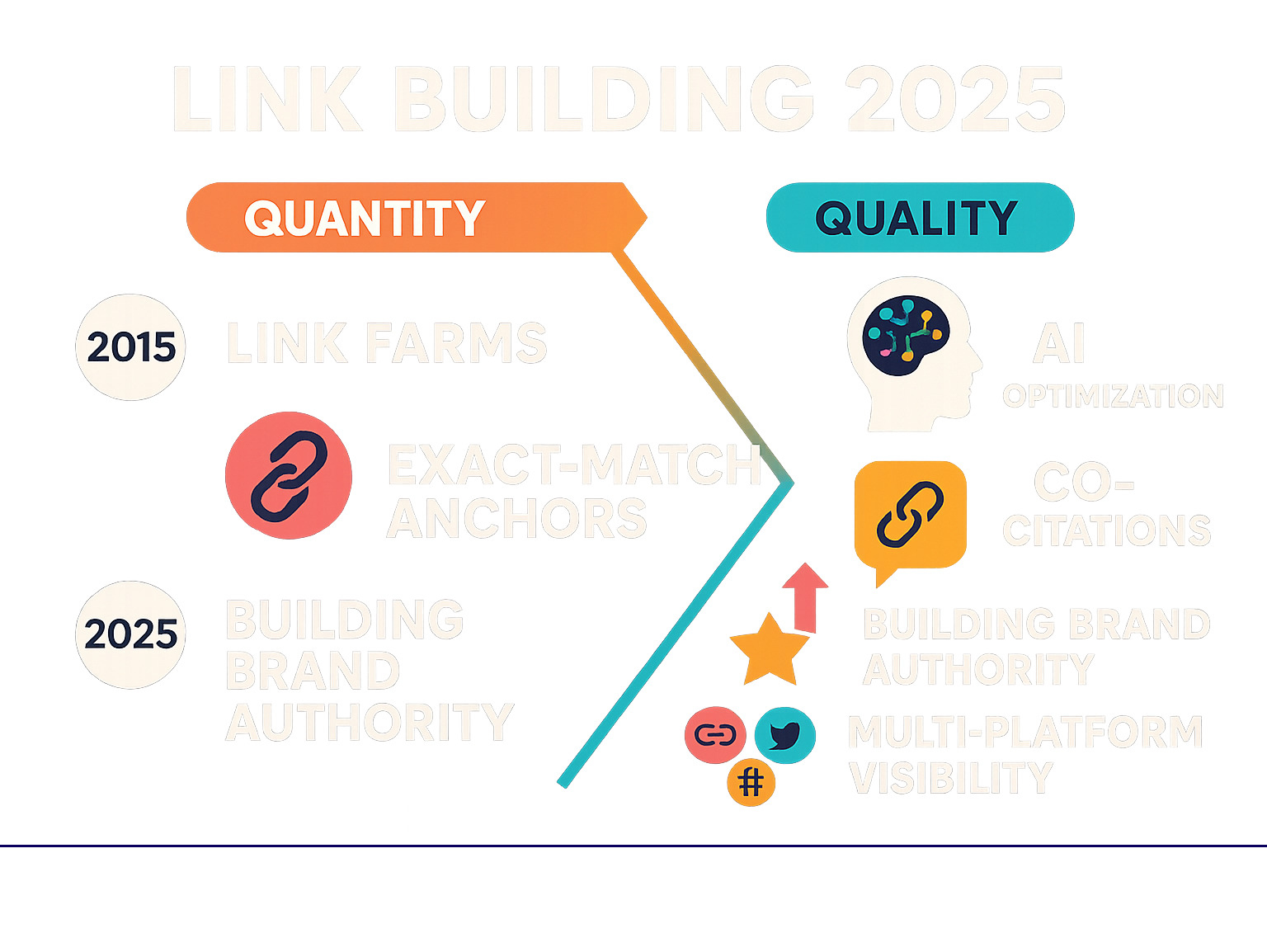Link Building 2025: Master 4 Core Strategies
Why Links Still Reign Supreme in 2025
Link building 2025 strategies have evolved, but backlinks remain a powerful SEO ranking factor. Here’s what you need to know:
Key Changes in Link Building for 2025:
- Quality over quantity – One high-authority link beats 100 low-quality ones
- AI and co-citations – Brand mentions without links now matter for LLM training
- Context matters more – Relevance trumps anchor text optimization
- Multi-platform authority – Links help across search, AI, and social platforms
The reality is that 99.5% of websites get no traffic from Google, often due to a lack of quality backlinks. Many business owners still use outdated tactics that are no longer effective.
Google’s smarter algorithms reward relevance, quality, and real engagement over manipulative schemes. The focus has shifted from gaming the system to genuinely earning trust and authority.
What’s changed since 2020:
- AI search engines cite sources differently
- Co-citations (brand mentions alongside authorities) build topical relevance
- Content quality directly impacts link attraction
- White-hat strategies are essential for long-term success
These changes favor businesses that create real value. When you solve problems and build relationships, links follow.

The New Landscape: From Backlinks to Brand Signals
In link building 2025, the game has changed. We’re no longer just competing for Google’s attention, but for visibility across all platforms where users seek information—traditional search, AI answers, social media, and forums.
This shift toward “Search Everywhere Optimization” is driven by AI. When you ask an AI chatbot a question or see Google’s AI provide a direct answer, you’re witnessing this change. AI models pull answers directly from the web, analyzing context, authority, and relevance in sophisticated ways.
Statistics show that about 60% of searches now end without a click; AI serves the answer directly. This means the traditional backlink has evolved. It’s now a signal that helps AI models understand your brand’s identity and expertise.
The evolved value of a backlink extends beyond SEO metrics. A quality link teaches the internet’s AI systems to associate your brand with specific topics, essentially vouching for you in digital conversations.
Context has become king, often outweighing traditional anchor text optimization. AI models care more about who mentions you and in what context than the exact anchor text. This is Generative Engine Optimization (GEO), and early adopters are seeing up to a 40% increase in AI-powered visibility.
The smartest brands now focus on building findability across platforms, earning both traditional backlinks and co-citations.
What is a Co-Citation and Why Does It Matter?
A co-citation is a key part of modern link building 2025 strategies. It occurs when your brand is mentioned alongside other authoritative sources in the same content, even without a direct link. Being in such company sends a powerful signal.
AI models take note of these associations. When Large Language Models (LLMs) see your brand mentioned next to established authorities, they connect you to those conversations, building your topical authority.
Every time your brand is mentioned with industry leaders, you’re training AI to see you as relevant and trustworthy. This is how LLMs learn to reference your brand in search results. Some of the most valuable brand mentions aren’t even clickable, yet they shape how AI perceives your market position.
The authenticity of co-citations is their strength. You can’t fake being mentioned alongside authorities; it happens when you genuinely contribute value. This trains LLMs to connect your brand with the right topics, boosting your credibility in the age of AI-driven search.
Creating Content for Humans and AI
Creating content for both humans and AI is straightforward: focus on genuine value and clear communication.
Start with E-E-A-T—Expertise, Experience, Authority, and Trust. These are the foundations of content that people and AI systems value. Demonstrating real knowledge, sharing authentic experiences, and earning trust through quality and consistency is crucial.
Value-driven content is the best way to attract links. Research shows that comprehensive content (over 3,000 words) earns about 3.5 times more backlinks than shorter articles. This isn’t about word count, but about providing thorough, helpful answers that people want to share.
The best content answers user intent directly. Visitors should find exactly what they need, which naturally attracts links from other creators who want to reference useful resources.
For AI systems, use structured data and clear, factual writing. Use descriptive headings, bullet points, and short, digestible paragraphs that are easy for both humans and AI to parse.
About 90% of marketers use content creation as their primary backlink strategy for a reason. Quality content creates a virtuous cycle: humans share it, AI understands it, and search engines reward it. The goal is to create content so valuable that it’s referenced naturally. For more insights, check out these web marketing strategies that complement your link building efforts.
Actionable Link Building 2025 Strategies
A successful link profile in today’s landscape requires a diversified approach. Smart businesses spread their efforts across multiple strategies to create a sustainable, natural-looking link profile.
The golden rule is that no single method should dominate more than 30-40% of your overall link profile. This diversity looks more natural to search engines and protects you if one strategy becomes less effective.
The focus has shifted to ethical, white-hat methods that prioritize genuine value over quick wins. This is about building real authority that stands the test of time.
At MDM Marketing, our data-driven SEO solutions combine technical expertise with compelling content, helping businesses build sustainable online authority. Modern link building 2025 emphasizes relationship-building and value creation. When you focus on solving problems and creating connections, links become a natural byproduct.
Strategy 1: Develop “Citation Magnet” Linkable Assets
Citation magnets are pieces of content so valuable that other websites, journalists, and AI models naturally want to reference them. They attract links effortlessly.

- Original research and data studies are goldmines for links. Industry reports with fresh insights provide exclusive information that journalists and bloggers need.
- Free tools and calculators solve immediate problems for users. These assets attract links long after publication because they provide ongoing value.
- Comprehensive guides and expert roundups become go-to references that people bookmark and share repeatedly.
The key is creating something that helps people accomplish their goals. When your asset solves a real problem, sharing it becomes automatic.
Strategy 2: Master Strategic Guest Blogging
In link building 2025, guest blogging is about strategic brand placement and establishing industry authority. The new approach focuses on engineering relevance by seeking the right audience, not just the biggest one.
Brand placement is central. Instead of forcing links, create valuable content that naturally showcases your expertise. For example, a financial advisor might write about retirement planning, positioning their services as part of the solution.
Building genuine relationships with industry professionals leads to ongoing collaborations and referrals. Your guest posts should provide real insights that readers remember. When you consistently deliver value, editors invite you back.
Pitching relevant publishers means targeting sites where your ideal clients spend time. Look for publications with clear editorial standards, as this indicates quality. Nearly 65% of marketers still use guest posting, but success comes from a quality-first mindset.
Strategy 3: Reclaim and Repurpose Existing Opportunities
Some of the easiest wins in link building 2025 are hiding in plain sight.
- Unlinked brand mentions are immediate opportunities. Use a search operator like
intext:"Your Company Name" -yourwebsite.comto find them. A friendly outreach email thanking the author and suggesting a link often works. - The “Moving Man Method” capitalizes on change. When companies rebrand or discontinue services, sites are left linking to outdated resources. You can point out these links and offer your relevant content as a replacement.
- Broken link building is similar. Find relevant pages linking to dead resources, report the broken link, and suggest your content as a working alternative.
- Updating existing backlinks ensures your links point to your most relevant pages. A simple request to update an old link to newer content can improve its value.
These strategies work because they provide genuine value and improve the web for everyone.
Strategy 4: Engage in Digital PR and Outreach
Digital PR transforms your expertise into media coverage and high-quality editorial links.
- Becoming a source for reporters opens doors to media mentions. Platforms connect experts with journalists seeking quotes or data. Providing credible information earns mentions in reputable publications.
- Reactive PR (newsjacking) involves responding to trending topics with your expert perspective. Offering timely commentary on breaking news can secure valuable media coverage.
- Podcast guest appearances offer brand exposure and natural backlinks. With over 42% of Americans listening to podcasts monthly, this medium provides access to engaged audiences. Most podcasts link to guest websites in their show notes.
- Leveraging personal networks often produces the most natural links. Professional and personal connections can uncover collaboration opportunities that cold outreach might miss.
- Social proof and sharing amplify your content’s reach. While social links don’t directly impact SEO, content that gains traction on social media is more likely to be found and linked to by other websites. Over 61% of link builders integrate social platforms into their strategies.
Best Practices and Pitfalls to Avoid
Successful link building 2025 is about building a robust, ethical link profile that lasts, not just collecting links. It requires consistency and patience. Most businesses see meaningful results around 3.1 months, though some notice changes sooner.
Don’t obsess over link counts. What matters is the quality of your referring domains, their relevance to your business, and whether they help real people find you.
The smartest approach focuses on long-term success by measuring impact on actual business goals like qualified traffic, brand recognition, and customer acquisition.
White Hat vs. Gray Hat vs. Black Hat
There are three paths in link building, but only one ensures safety and sustainability.
- White hat link building is the ethical approach. It focuses on earning links naturally through valuable content, real relationships, and creating resources people want to share. This includes guest posting, creating useful tools, and earning media mentions.
- Gray hat tactics bend the rules. They aren’t explicitly forbidden but are risky. Examples include excessive link exchanges or buying placements that feel more commercial than editorial. They might offer short-term gains but risk penalties.
- Black hat link building involves manipulative tactics that try to trick Google, such as buying paid links, using private blog networks (PBNs), or automated spam. Google actively penalizes these methods.
Google’s Link Spam policies clarify what is acceptable. White hat isn’t just recommended—it’s essential for long-term survival.
Common Mistakes in Link Building 2025
Avoid these common mistakes that can sabotage your efforts.
- Chasing quantity over quality: One link from a respected industry publication is better than 100 links from irrelevant, low-quality sites.
- Ignoring relevance: A link’s context matters. If you run a dental practice, a link from a medical journal is valuable; a link from a hiking blog is not. Google notices when a link profile doesn’t make sense.
- Over-optimizing anchor text: If every link uses the exact same keyword phrase, it looks unnatural to Google. Real links use varied, natural language, including your brand name or simple phrases like “click here.”
- Neglecting internal linking: While building external links, ensure your own pages are connected logically. This helps users steer your site and shows Google how your content is related.
- Focusing on vanity metrics: Don’t get distracted by metrics like Domain Authority (DA). A site with engaged, relevant traffic is better than a high-DA site with random visitors. Focus on traffic quality and genuine relevance.
At MDM Marketing in North Canton, OH, our data-driven approach focuses on building sustainable, white-hat link profiles. Link building 2025 is about building real relationships and providing real value—a strategy that never goes out of style.
Frequently Asked Questions about Link Building
How has AI changed link building for 2025?
AI has transformed link building 2025. AI tools now streamline link prospecting, opportunity analysis, and outreach, saving hours of manual work.
More importantly, AI is changing how links function. With Google’s Search Generative Experience and other AI answer engines, information consumption is shifting. Over 73% of marketers believe backlinks now influence whether a brand appears in AI-generated answers. When an AI tool needs an authoritative source, it’s more likely to reference well-linked, frequently cited content.
However, AI has also made search engines smarter at detecting low-quality efforts. Over 70% of major search engines use AI to penalize spammy, AI-generated backlinks. The key is using AI to improve quality, not just volume. AI-improved content is 40% more likely to earn high-authority backlinks when done right.
AI has made link building more efficient but also more demanding. High-quality, helpful content is essential to stand out.
What is more important: link quality or quantity?
Quality wins every time in link building 2025. The days of simply collecting links are over.
One authoritative, relevant link can boost your rankings more than hundreds of low-quality ones, which can actually be harmful. Nearly 94% of link builders now prioritize quality over quantity.
What makes a link high-quality? It comes from a relevant, authoritative website and is placed in a context that makes sense. For a law firm, a link from a legal journal is far more valuable than one from a pet grooming blog.
Google understands these nuances, evaluating the relevance, authority, and contextual placement of each link to build a picture of your expertise. The best approach is to build a diverse link profile from various high-quality sources, like a network of professional references.
How long does it take to see results from link building?
Link building is a long-term strategy, not a quick fix. Anyone promising instant results is likely using risky tactics.
Most businesses see noticeable results within about 3 months of consistent effort, with a typical range of 1 to 6 months. The timeline depends on factors like industry competitiveness, your website’s starting authority, and the consistency of your efforts.
Immediate benefits like referral traffic and brand mentions can appear sooner, providing early wins. Consistency matters more than intensity. Earning a few high-quality links each month is better than a short-term, high-volume burst followed by inactivity. Search engines reward sustained effort and natural growth.
Link building results compound over time. Each quality link makes the next one easier to earn and more impactful.
Conclusion: Building Authority for the Future
Link building 2025 represents a major shift in digital authority. The focus has moved beyond link counts to an era where AI, co-citations, and genuine brand building are central.
Search engines and AI models are now smarter at understanding context. They evaluate who mentions your brand, where, and in what context. Your authority is now built through a web of brand signals across multiple platforms, not just traditional backlinks.
A strategic, ethical approach is more important than ever. White-hat methods are essential for sustainable success, as Google’s penalties for manipulative tactics are severe.
At MDM Marketing in North Canton, OH, our data-driven approach to SEO and copywriting has evolved with these industry shifts. We know a successful link building 2025 strategy requires a balance of technical expertise and content that connects with people.
The future belongs to brands that think bigger, building multi-platform authority. This means creating content that resonates with humans while also training AI models to associate your brand with expertise and trust.
This involves developing valuable resources, building genuine industry relationships, and consistently providing insights that matter. The goal is to become a trusted voice that both humans and machines recognize as authoritative.
Patience and consistency are your greatest allies. Link building is a long-term game. Businesses that succeed will be those that commit to providing value consistently and authentically.
The digital landscape will keep evolving, but quality always wins. Whether creating linkable assets, engaging in digital PR, or developing partnerships, brands that prioritize genuine value will build authority that lasts.
Ready to build authority that stands the test of time? Consider how you can streamline your SEO with our outsourced services and create a link building strategy for long-term success.
About The SEO Experts at MDM Marketing
This author hasn't written a bio yet.

